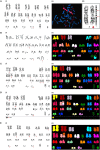Impact of Additional Chromosomal Aberrations on the Disease Progression of Chronic Myelogenous Leukemia
- PMID: 30891424
- PMCID: PMC6411713
- DOI: 10.3389/fonc.2019.00088
Impact of Additional Chromosomal Aberrations on the Disease Progression of Chronic Myelogenous Leukemia
Abstract
The emergence of additional chromosomal abnormalities (ACAs) in Philadelphia chromosome/BCR-ABL1 positive chronic myeloid leukemia (CML), is considered to be a feature of disease evolution. However, their frequency of incidence, impact on prognosis and treatment response effect in CML is not conclusive. In the present study, we performed a chromosome analysis of 489 patients in different clinical stages of CML, using conventional GTG-banding, Fluorescent in situ Hybridization and Spectral Karyotyping. Among the de novo CP cases, ACAs were observed in 30 patients (10.20%) with lowest incidence, followed by IM resistant CP (16.66%) whereas in AP and BC, the occurrence of ACAs were higher, and was about 40.63 and 50.98%, respectively. The frequency of occurrence of ACAs were compared between the study groups and it was found that the incidence of ACAs was higher in BC compared to de novo and IM resistant CP cases. Likewise, it was higher in AP patients when compared between de novo and IM resistant CP cases, mirroring the fact of cytogenetic evolution with disease progression in CML. In addition, we observed 10 novel and 10 rare chromosomal aberrations among the study subjects. This study pinpoints the fact that the genome of advanced phase patients was highly unstable, and this environment of genomic instability is responsible for the high occurrence of ACAs. Treatment response analysis revealed that compared to initial phases, ACAs were associated with an adverse prognostic effect during the progressive stages of CML. This study further portrayed the cytogenetic mechanism of disease evolution in CML.
Keywords: GTG-banding; Philadelphia Chromosome; Spectral Karyotyping; additional chromosomal aberrations; blast crisis; chronic myeloid leukemia; fluorescent in situ hybridization; variant Ph translocation.
Figures





Similar articles
-
Prognostic Implications of Derivative Chromosome 9 Deletions in Patients with Advanced-Stage Chronic Myelogenous Leukemia.J Environ Pathol Toxicol Oncol. 2018;37(2):117-126. doi: 10.1615/JEnvironPatholToxicolOncol.2018026023. J Environ Pathol Toxicol Oncol. 2018. PMID: 30055547
-
Chronic myeloid leukemia with complex karyotypes: Prognosis and therapeutic approaches.J Cell Physiol. 2019 May;234(5):5798-5806. doi: 10.1002/jcp.27505. Epub 2018 Nov 14. J Cell Physiol. 2019. PMID: 30430567 Review.
-
Genomic amplification of BCR-ABL1 fusion gene and its impact on the disease progression mechanism in patients with chronic myelogenous leukemia.Gene. 2019 Feb 20;686:85-91. doi: 10.1016/j.gene.2018.11.005. Epub 2018 Nov 3. Gene. 2019. PMID: 30399426 Clinical Trial.
-
Cytogenetic landscape and impact in blast phase of chronic myeloid leukemia in the era of tyrosine kinase inhibitor therapy.Leukemia. 2017 Mar;31(3):585-592. doi: 10.1038/leu.2016.231. Epub 2016 Aug 18. Leukemia. 2017. PMID: 27560111
-
Cytogenetic and molecular genetic evolution of chronic myeloid leukemia.Acta Haematol. 2002;107(2):76-94. doi: 10.1159/000046636. Acta Haematol. 2002. PMID: 11919388 Review.
Cited by
-
Resistance to Tyrosine Kinase Inhibitors in Chronic Myeloid Leukemia-From Molecular Mechanisms to Clinical Relevance.Cancers (Basel). 2021 Sep 26;13(19):4820. doi: 10.3390/cancers13194820. Cancers (Basel). 2021. PMID: 34638304 Free PMC article. Review.
-
Chromosomal Variations and Clinical Features of Acute Lymphoblastic Leukemia in the North Indian Population: A Cross-Sectional Study.Cureus. 2024 May 16;16(5):e60451. doi: 10.7759/cureus.60451. eCollection 2024 May. Cureus. 2024. PMID: 38883069 Free PMC article.
-
Chronic Myeloid Leukemia, from Pathophysiology to Treatment-Free Remission: A Narrative Literature Review.J Blood Med. 2023 Apr 6;14:261-277. doi: 10.2147/JBM.S382090. eCollection 2023. J Blood Med. 2023. PMID: 37051025 Free PMC article. Review.
-
Philadelphia chromosome positive chronic myeloid leukemia with 5q deletion at diagnosis.Mol Cytogenet. 2021 Mar 8;14(1):16. doi: 10.1186/s13039-021-00539-0. Mol Cytogenet. 2021. PMID: 33685471 Free PMC article.
-
Chromosomal Instability in Chronic Myeloid Leukemia: Mechanistic Insights and Effects.Cancers (Basel). 2022 May 21;14(10):2533. doi: 10.3390/cancers14102533. Cancers (Basel). 2022. PMID: 35626137 Free PMC article. Review.
References
LinkOut - more resources
Full Text Sources
Research Materials
Miscellaneous

